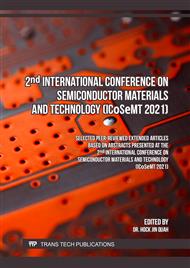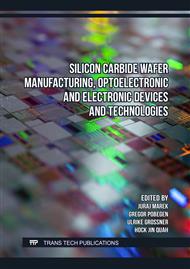[1]
S. J. Sweeney and S. R. Jin, "Bismide-nitride alloys: Promising for efficient light emitting devices in the near- and mid-infrared," Journal of Applied Physics, vol. 113, no. 4, Jan. 2013.
DOI: 10.1063/1.4789624
Google Scholar
[2]
T. Thomas et al., "Requirements for a GaAsBi 1 eV sub-cell in a GaAs-based multi-junction solar cell," Semiconductor Science and Technology, vol. 30, no. 9, Sep. 2015.
DOI: 10.1088/0268-1242/30/9/094010
Google Scholar
[3]
V. Bahrami-Yekta, T. Tiedje, and M. Masnadi-Shirazi, "MBE growth optimization for GaAs1-xBix and dependence of photoluminescence on growth temperature," Semiconductor Science and Technology, vol. 30, no. 9, Sep. 2015.
DOI: 10.1088/0268-1242/30/9/094007
Google Scholar
[4]
T. B. O. Rockett et al., "Influence of growth conditions on the structural and opto-electronic quality of GaAsBi," Journal of Crystal Growth, vol. 477, p.139–143, Nov. 2017.
DOI: 10.1016/j.jcrysgro.2017.02.004
Google Scholar
[5]
C. J. Hunter et al., "Absorption characteristics of GaAs1?xBix/GaAs diodes in the near-infrared," IEEE Photonics Technology Letters, vol. 24, no. 23, p.2191–2194, 2012.
DOI: 10.1109/LPT.2012.2225420
Google Scholar
[6]
P. K. Patil et al., "GaAsBi/GaAs multi-quantum well LED grown by molecular beam epitaxy using a two-substrate-temperature technique," Nanotechnology, vol. 28, no. 10, Feb. 2017.
DOI: 10.1088/1361-6528/aa596c
Google Scholar
[7]
R. D. Richards, F. Bastiman, D. Walker, R. Beanland, and J. P. R. David, "Growth and structural characterization of GaAsBi/GaAs multiple quantum wells," Semiconductor Science and Technology, vol. 30, no. 9, Sep. 2015.
DOI: 10.1088/0268-1242/30/9/094013
Google Scholar
[8]
T. B. O. Rockett, N. A. Adham, F. Harun, J. P. R. David, and R. D. Richards, "Growth of GaAsBi/GaAs multiple quantum wells with up to 120 periods," Journal of Crystal Growth, vol. 589, Jul. 2022.
DOI: 10.1016/j.jcrysgro.2022.126679
Google Scholar
[9]
R. D. Richards et al., "Photovoltaic characterisation of GaAsBi/GaAs multiple quantum well devices," Solar Energy Materials and Solar Cells, vol. 172, p.238–243, Dec. 2017.
DOI: 10.1016/j.solmat.2017.07.029
Google Scholar
[10]
R. D. Richards, F. Bastiman, J. S. Roberts, R. Beanland, D. Walker, and J. P. R. David, "MBE grown GaAsBi/GaAs multiple quantum well structures: Structural and optical characterization," Journal of Crystal Growth, vol. 425, p.237–240, Jul. 2015.
DOI: 10.1016/j.jcrysgro.2015.02.053
Google Scholar
[11]
Y. I. Mazur et al., "Effects of AlGaAs cladding layers on the luminescence of GaAs/GaAs 1− x Bi x /GaAs heterostructures," Nanotechnology, vol. 25, no. 3, p.035702, Jan. 2014.
DOI: 10.1088/0957-4484/25/3/035702
Google Scholar
[12]
R. D. Richards et al., "Molecular beam epitaxy growth of GaAsBi using As2 and As 4," Journal of Crystal Growth, vol. 390, p.120–124, Mar. 2014.
DOI: 10.1016/j.jcrysgro.2013.12.008
Google Scholar
[13]
Z. Zhou, D. F. Mendes, R. D. Richards, F. Bastiman, and J. P. David, "Absorption properties of GaAsBi based p-i-n heterojunction diodes," Semiconductor Science and Technology, vol. 30, no. 9, Sep. 2015.
DOI: 10.1088/0268-1242/30/9/094004
Google Scholar
[14]
H. M. Khalil, B. Royall, S. Mazzucato, and N. Balkan, "Photoconductivity and photoluminescence under bias in GaInNAs/GaAs MQW p-i-n structures," Nanoscale Research Letters, vol. 7, no. 1, p.539, Dec. 2012.
DOI: 10.1186/1556-276X-7-539
Google Scholar
[15]
A. R. Mohmad et al., "Localization effects and band gap of GaAsBi alloys," Physica Status Solidi (B) Basic Research, vol. 251, no. 6, p.1276–1281, 2014.
DOI: 10.1002/pssb.201350311
Google Scholar
[16]
R. Kudrawiec et al., "Experimental and theoretical studies of band gap alignment in GaAs 1−x Bi x /GaAs quantum wells," Journal of Applied Physics, vol. 116, no. 23, p.233508, Dec. 2014.
DOI: 10.1063/1.4904740
Google Scholar
[17]
K. Kakuyama, S. Hasegawa, H. Nishinaka, and M. Yoshimoto, "Impact of a small change in growth temperature on the tail states of GaAsBi," Journal of Applied Physics, vol. 126, no. 4, p.045702, Jul. 2019.
DOI: 10.1063/1.5109362
Google Scholar
[18]
L V Keldysh, "Behavior of Non-Metallic Crystals in Strong Electric Fields," Soviet Physics Jetp, vol. 6, no. 4, p.763–770, 1958.
Google Scholar
[19]
S M Sze and K K Ng, Physics of Semiconductor Devices, Third Edition. New Jersey, 2007.
Google Scholar
[20]
S. Adachi, "Optical dispersion relations for GaP, GaAs, GaSb, InP, InAs, InSb, Al x Ga 1− x As, and In 1− x Ga x As y P 1− y ," Journal of Applied Physics, vol. 66, no. 12, p.6030–6040, Dec. 1989.
DOI: 10.1063/1.343580
Google Scholar
[21]
F. Urbach, "The Long-Wavelength Edge of Photographic Sensitivity and of the Electronic Absorption of Solids," Physical Review, vol. 92, no. 5, p.1324–1324, Dec. 1953.
DOI: 10.1103/PhysRev.92.1324
Google Scholar
[22]
C. Gogineni, N. A. Riordan, S. R. Johnson, X. Lu, and T. Tiedje, "Disorder and the Urbach edge in dilute bismide GaAsBi," Applied Physics Letters, vol. 103, no. 4, Jul. 2013.
DOI: 10.1063/1.4816435
Google Scholar
[23]
M. Masnadi-Shirazi, R. B. Lewis, V. Bahrami-Yekta, T. Tiedje, M. Chicoine, and P. Servati, "Bandgap and optical absorption edge of GaAs 1−x Bi x alloys with 0 < x < 17.8%," Journal of Applied Physics, vol. 116, no. 22, p.223506, Dec. 2014.
DOI: 10.1063/1.4904081
Google Scholar
[24]
R. D. Richards, C. J. Hunter, F. Bastiman, A. R. Mohmad, and J. P. R. David, "Telecommunication wavelength GaAsBi light emitting diodes," IET Optoelectronics, vol. 10, no. 2, p.34–38, Apr. 2016.
DOI: 10.1049/iet-opt.2015.0051
Google Scholar
[25]
S. R. Johnson and T. Tiedje, "Temperature dependence of the Urbach edge in GaAs," Journal of Applied Physics, vol. 78, no. 9, p.5609–5613, 1995.
DOI: 10.1063/1.359683
Google Scholar
[26]
S. Imhof et al., "Clustering effects in Ga(AsBi)," Applied Physics Letters, vol. 96, no. 13, 2010.
DOI: 10.1063/1.3374884
Google Scholar
[27]
R. B. Lewis, D. A. Beaton, X. Lu, and T. Tiedje, "GaAs1 - x Bix light emitting diodes," Journal of Crystal Growth, vol. 311, no. 7, p.1872–1875, Mar. 2009.
DOI: 10.1016/j.jcrysgro.2008.11.093
Google Scholar
[28]
S. Francoeur, S. Tixier, E. Young, T. Tiedje, and A. Mascarenhas, "Bi isoelectronic impurities in GaAs," Physical Review B - Condensed Matter and Materials Physics, vol. 77, no. 8, Feb. 2008.
DOI: 10.1103/PhysRevB.77.085209
Google Scholar



